The Hulbjerg Jættestue is a Neolithic burial site located on the island of Langeland in Denmark. This megalithic tomb, dating back to around 3000 BC, is a remarkable example of early human engineering and spiritual beliefs. It consists of a large passage grave, which is a type of collective burial site commonly found in Scandinavia and other parts of Europe during the Neolithic period. The Hulbjerg Jættestue stands as a testament to the sophistication of the Funnelbeaker culture, which constructed these monumental structures as part of their ceremonial and religious practices.
Get your dose of History via Email
Historical Background of Hulbjerg Jættestue
The Hulbjerg Jættestue was discovered in the 19th century, revealing its historical significance. It was built by the Funnelbeaker culture, known for their megalithic tombs. The site has been examined by archaeologists who have unearthed artifacts and human remains, providing insights into the Neolithic way of life. The tomb’s construction reflects the collective effort and social organization of the community that built it. Over time, the site has been preserved, allowing visitors to glimpse into a prehistoric past.
Archaeological evidence suggests that the Hulbjerg Jættestue was not only a burial site but also a ceremonial space. The builders of this tomb were part of a wider megalithic tradition that spanned across Europe. The Funnelbeaker culture is credited with the construction of this and other similar sites. These structures were feats of engineering that required a deep understanding of stonework and construction techniques prevalent during the Neolithic era.
The Hulbjerg Jættestue has not been the scene of any historically significant events in recent history. However, its very existence and preservation are crucial for understanding the Neolithic period in Scandinavia. The site has not been reported to have had inhabitants after its initial use. It remains a static monument to the people who built it thousands of years ago.
While the Hulbjerg Jættestue is not a site of modern historical events, it is an essential link to the past. It provides a window into the beliefs, practices, and lives of the Neolithic people. The site’s preservation allows for ongoing research and education, offering valuable lessons about human history and cultural development.
The discovery and subsequent studies of the Hulbjerg Jættestue have contributed significantly to the understanding of Neolithic societies in Northern Europe. The site continues to be a focal point for archaeological research, attracting scholars interested in the early history of human settlement, spirituality, and social organization.
About Hulbjerg Jættestue
The Hulbjerg Jættestue is characterized by its large stone construction and earthen mound. The tomb comprises a long passage leading to a burial chamber, which is covered by a mound of earth. The chamber itself is built with large boulders, supporting capstones that create a roof. The structure’s design is typical of passage graves, intended for multiple burials over an extended period.
The building materials for the Hulbjerg Jættestue were sourced locally, showcasing the builders’ knowledge of their environment. The large stones, known as megaliths, were transported and erected using primitive tools and methods. The construction of such a site would have required a significant communal effort, indicative of a well-organized society with social hierarchies.
Architectural highlights of the Hulbjerg Jættestue include the intricately placed stones that form the passage and chamber. The precision with which these stones were laid suggests a high level of skill and planning. The mound covering the tomb adds to its grandeur and has helped preserve the structure over millennia.
The interior of the Hulbjerg Jættestue is sparse, with the main focus being on the burial chamber. This chamber was where the remains of the dead were placed, along with various grave goods that are believed to have held significance in the afterlife. The artifacts found within the tomb provide clues about the culture and beliefs of the people who built it.
Overall, the Hulbjerg Jættestue is a remarkable example of Neolithic architecture. Its preservation allows for a detailed study of its construction techniques and materials, offering insights into the capabilities and customs of the Funnelbeaker culture.
Theories and Interpretations
Several theories exist about the purpose and significance of the Hulbjerg Jættestue. Most scholars agree that it served as a communal burial site, reflecting the collective nature of Neolithic societies. The presence of grave goods suggests beliefs in an afterlife where such items were necessary.
Some interpretations propose that the Hulbjerg Jættestue had a ceremonial or ritualistic function beyond just burials. The alignment of the tomb and its entrance with certain astronomical events indicates a possible calendrical purpose or spiritual significance related to the cycles of the sun and moon.
Mysteries surrounding the Hulbjerg Jættestue include the exact rituals performed and the societal structure of the builders. While artifacts provide some clues, much of the cultural context has been lost to time. Researchers must piece together the past from the physical evidence left behind.
Historical records from the Neolithic period are non-existent, so interpretations of sites like the Hulbjerg Jættestue rely heavily on archaeological findings. Comparisons with other contemporary sites help to build a broader understanding of the culture and practices of the time.
Dating of the Hulbjerg Jættestue has been carried out using methods such as radiocarbon dating. These techniques have confirmed the tomb’s age and have helped to place it within the broader timeline of human history in the region.
At a glance
Country: Denmark
Civilization: Funnelbeaker culture
Age: Approximately 5000 years old (3000 BC)
Conclusion and Sources
Reputable sources used in the creation of this article include:
- Wikipedia: https://en.wikipedia.org/wiki/Hulbjerg_J%C3%A6ttestue
- Image credit: https://www.megalithic.co.uk/article.php?sid=24420

